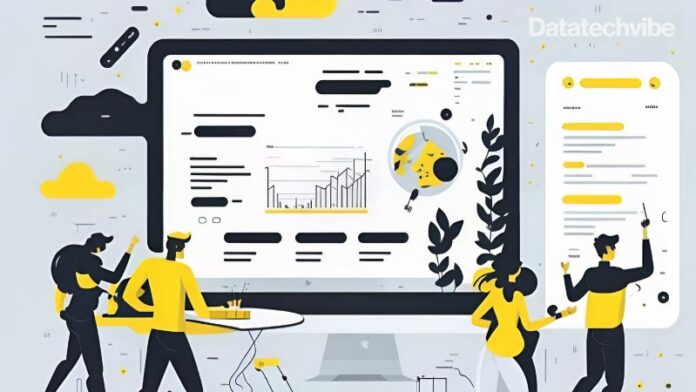How data storytelling revolutionises communication and influences customer behaviour. Learn the art of crafting compelling narratives from complex data, ensuring your message resonates.
Having all the information and numbers at our fingertips doesn’t make communication any easier. When you have overwhelming data to sift through, it becomes more difficult to filter down to the parts that take your brand from the shadows and put it in the spotlight where your customers can see you.
Further, it’s not enough to analyse data. You need to use insights and visuals to narrate the story your data tells in a clear, coherent manner—an approach called data storytelling.
Data Storytelling vs. Data Visualisation
While data storytelling uses data and analytics to build a compelling narrative for your audience, data visualisation is simply the visual representation of this data. It can go from basic charts and tables to building appealing maps and diagrams that draw focus to your key findings.
Data stories are often compared with data visualisations. However, data visualisations are just one piece of data stories and are used as an aid to tell a broader story. But the fact remains: One can’t go without the other.
We must remember that people aren’t naturally good at data storytelling. When you’re reading a story to a child, you use a picture book to remind them what happened throughout the story and support their ability to retell the key events confidently.
Just like pictures help kids -and adults- develop their basic literacy skills, using visuals in data storytelling is essential in increasing data literacy and getting your point across. It can:
- Provide context.
- Draw attention to key insights.
- Lead to customer action.
It takes a true data scientist to use data storytelling and visualisation. Businesses can influence decision-making and garner positive responses by learning to present data in a way that visualises the findings and tells a story
Why is data storytelling important for your customers? Storytelling is within our human nature.
Humans have used visuals for centuries: From drawings in caves 30,000 years ago to hieroglyphics and petroglyphs, our great ancestors used stone and clay to tell their stories about life and survival.
It’s in our nature to tell stories. The way we tell them might have changed due to technological advancements. Still, the truth is that storytelling will always be a fundamental necessity for communication, even more so for customers.
“The way we experience story will evolve, but as storytelling animals, we will no more give it up than start walking on all fours.”
- Jonathan Gottschall
People read information, but they feel a story.
A study by Dr Jerome Bruner found that messages delivered as stories can be up to 22 times more memorable than just the facts. This is because the human brain is wired for a story, and we’re also wired to remember them. When we remember them, we can pass them around. So, chances are a customer will retell a story before they can ever retell a fact.
Numbers fade while stories stick.
While numbers are essential in boosting your credibility when presenting, solely relying on them to persuade your audience is called a “Lazy Victory”. Quoting numbers is easy, but it doesn’t change behaviour. Businesses must appeal to the audience’s emotions before appealing to their logic. Enter data storytelling: The compelling narrative surrounding the complex numbers you’re presenting. It leads to persuasive presentations that stick with your audience instead of hit-and-run presentations that leave them wondering.
How do we create a compelling data narrative that increases audience engagement?
To tell a story with data, the first step is to develop a compelling data narrative that includes the same elements as the traditional story: Setting, characters, conflict, and resolution.
To illustrate this, let’s say you own an online store and are looking for ways to improve the customer journey. You’ve noticed that many customers are abandoning their carts at the checkout page.
Characters
These include the players and stakeholders, along with your internal team and customers who get stuck in their journeys at the checkout page. This doesn’t need to be part of the presentation, but identifying key players before any presentation is necessary for the presenter.
Setting
Set the scene by explaining a recent percentage increase in the bounce rates over the past month. Use a data visualisation tool to show the decline across channel types and highlight the largest drop in abandoned carts.
Conflict
Your business uses specific intelligence to study customer journey touchpoints. This deep dive identified the conflict: There were areas where messaging wasn’t clear or was missing entirely, thus creating customer stress and confusion.
Resolution
To resolve, you propose key tactics to understand precisely where the confusion arose and address it:
- Conduct customer surveys to get feedback on the current messaging.
- Identify the key messages that customers must communicate at each touchpoint.
- Use clear and concise language that is easy to understand.
- Avoid jargon and technical terms.
- Be consistent with messaging across all touchpoints.
- Test the new messaging with a small group of customers before rolling it out to everyone.
The ‘Why’ of Data Storytelling
Turning data into action is the main objective of data storytelling. So, whatever story your data tells should be told in a way that helps the audience understand the data and, most importantly, take action based on it.
While data storytelling is a powerful tool, leveraging it for business success can be difficult. Centro offers advanced data solutions and tools to help you drive action and make smarter decisions for your business and customers. To learn more, contact one of our data experts and create a better customer experience that brings long-term value to your business.









